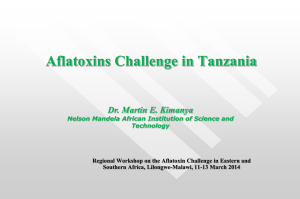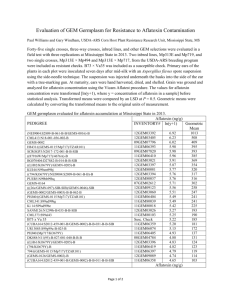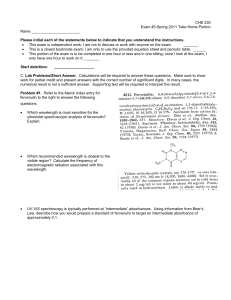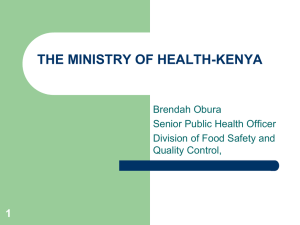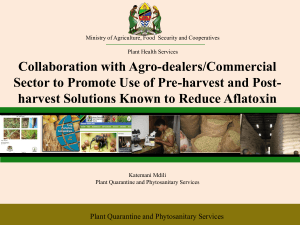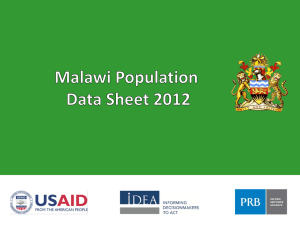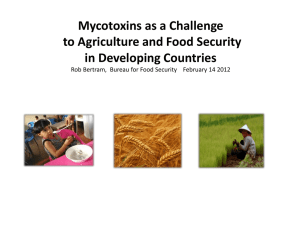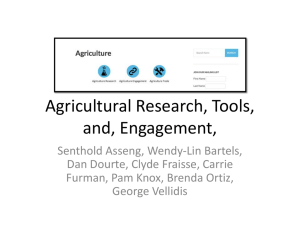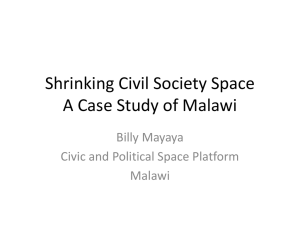Malawi_PACA-COMESA presentation - Malawi
advertisement
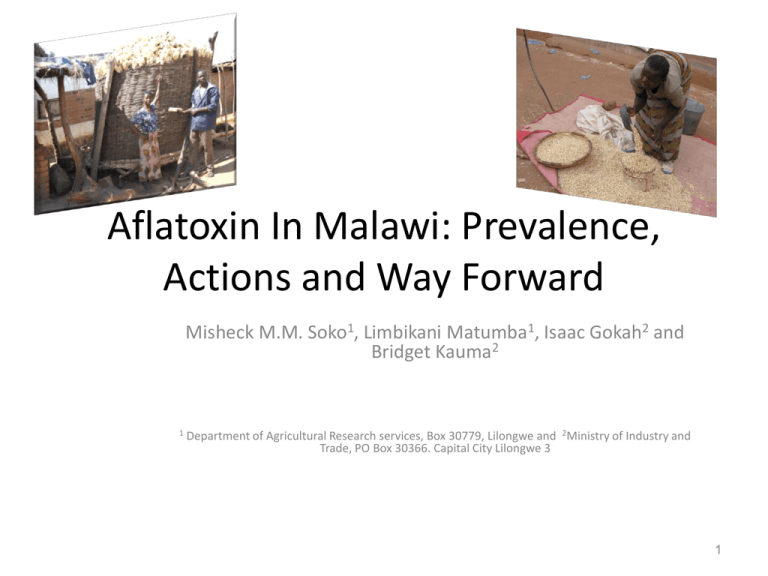
Aflatoxin In Malawi: Prevalence, Actions and Way Forward Misheck M.M. Soko1, Limbikani Matumba1, Isaac Gokah2 and Bridget Kauma2 1 Department of Agricultural Research services, Box 30779, Lilongwe and 2Ministry of Industry and Trade, PO Box 30366. Capital City Lilongwe 3 1 Background • Agricultural based economy producing crops both for food and sale (domestic and export) • Lies in tropics where climate is conducive for : – Groundnuts, maize (plus other cereals) and cassava production– staple and for economic livelihood – All conducive to Mycotoxin production including aflatoxin 2 Safety of food in Malawi… •Farmer awareness of aflatoxins: 28% •2/3 of the farmers thought its only peanut problem 1 1Matumba et al Unpublished results 3 Extent of Aflatoxin contamination in Malawi Product Survey yr # of samples Tolerable level (μg/kg) >Tolerable level (μg/kg) Mean±STDev.(μg/kg) Maize1 2011 90 3* 34% 164±248 Maize2 2012 180 3* 43% 70±107 Maize based 2012 9 10** 89% 90±95 Peanut butter4 2012 14 10** 100% 76±23 Groundnuts5 2008 1053 4*** 46% - Groundnuts 5 2009 4*** 23% - beer3 1-Matumba et al. manu in prep; 2-Matumba et al., 2013; World Mycotoxin Journal 6(4): 367-373 3-Matumba et al., 2014. Food Control 39: 87-914 4-Matumba et al., 2014. Food control 36: 253-256 5-Monyo et al., 2012. Crop Protection 42: 149-155 *Standard for ready to eat food: CAC ,1995 (CODEX STAN 193-1995). ** Malawi Bureau of Standards ** ** EC regulation 4 Regulation of mycotoxins In Malawi • Mycotoxin regulations have little impact on agrarian setup in Malawi – Production is subsistence : 85% of population producing their own – 65% of population are poor and 36% ultra poor(<$1/day) making practically impossible for people to discard contaminated food 5 Origin of Malawi Program for Aflatoxin Control (MAPAC) • Multi Criteria Decision Analysis to Identify and Prioritize Key Sanitary and Phytosanitary (SPS) Capacity Building Options and Needs for Malawi resulted in identification of 16 capacity building options and needs • Aflatoxin being amongst the first 4 that were consistently ranked as high priority • Scoping study conducted and resulted in the MAPAC document 6 The Aflatoxin Mitigation Challenge in Malawi • Piecemeal approach to Aflatoxin control with little impact • Lack of “National” effort to mitigate aflatoxin contamination – the reason for MAPAC • Regional involvement patchy and limited 7 Rational for MAPAC It is a national program that: • takes stock of existing initiatives to address aflatoxin contamination in groundnuts and maize • Identifies outstanding gaps • prioritizes and promote coordination and synergies among various stakeholders involved in addressing aflatoxin-related problems • An initial effort to: – create a shared vision and prioritize entry points, and suggests mechanisms for effective coordination and collaboration – A conduit to effectively engage in regional/ continental efforts such as PACA 8 Objectives of MAPAC • Develop Malawi’s capacity to effectively control aflatoxins in key value chains (esp. for Groundnut & Maize) 9 MAPAC Components 1. Mainstreaming (Integrating) Good Practices and Technologies into key Value Chains – Research – resistance screening, Biocontrol (initiatives in place – USAID interested in funding this aspect) – awareness creation, training and technology dissemination – Strengthening supply-chain coordination for mainstreaming practices/ technologies; 2. Testing, Standards & Policies – Diagnostic testing and accreditation – Standards, regulations and policy frameworks – Increase access to rapid screening for mycotoxin to farmers 3. Public awareness, advocacy, and consumer education • Augment farmers’ knowledge about Pre- and Post-harvest prevention and management strategies for mycotoxins (not only aflatoxin) 10 A shared vision: Advancing Collaboration for Effective Aflatoxin Control in Malawi 11

